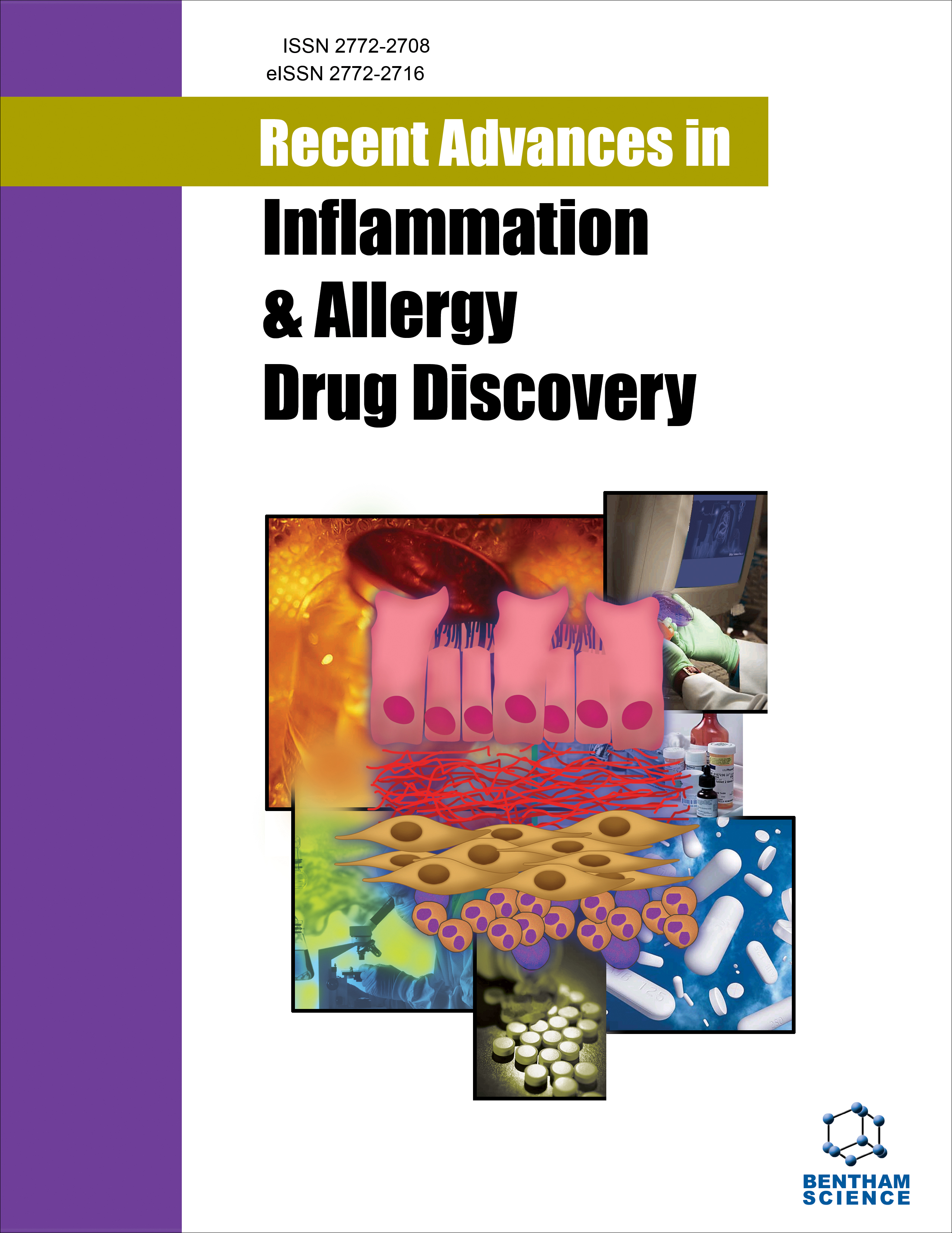- Home
- A-Z Publications
- Recent Advances in Inflammation & Allergy Drug Discovery
- Previous Issues
- Volume 18, Issue 2, 2024
Recent Advances in Inflammation & Allergy Drug Discovery - Volume 18, Issue 2, 2024
Volume 18, Issue 2, 2024
-
-
Biological Potential and Therapeutic Effectiveness of Phytoproduct ‘Fargesin’ in Medicine: Focus on the Potential of an Active Phytochemical of Magnolia fargesii
More LessAuthors: Kanika Patel and Dinesh Kumar PatelFlos Magnoliae is one of the important medicinal plants in different traditional medicine, including Chinese herbal medicine. Lignans and neolignans, including tetrahydrofurofuran, tetrahydrofuran, and aryltetralin, are present in the Flos Magnoliae species. A wide range of pharmacological activity of Flos Magnoliae has been reported in medicine. Fargesin has been isolated from Magnolia fargesii and it is a lignan-class phytochemic Read More
-
-
-
Beyond Pharmaceuticals: Harnessing the Potential of Plant-based Compounds for Anti-inflammatory Therapy
More LessAuthors: Vishnu Mittal and Anjali SharmaA complicated biological reaction of vascular tissues to damaging stimuli like infections, harmed cells, or irritants is called inflammation. Symptoms include redness, inflamed joints, stiffness, discomfort in the joints, and loss of joint function. NSAIDs are frequently used to treat inflammation. Sadly, these drugs raise the possibility of blood clots, which can result in heart attacks and strokes. Consequently, there is ongoing resea Read More
-
-
-
Evaluation of Serum Levels of Vitamin D3 and IgE in Patients with Chronic and Allergic Sinusitis: A Cross-sectional Study
More LessAuthors: Payman Bagheri, Majid Nouri, Hesam Eskandarzadeh and Mohammad DarvishiBackground: Chronic rhinosinusitis is known as a common problem with inflammatory and allergic causes. Several factors are associated with developing chronic rhinosinusitis, including immunoglobulin E (IgE) production and vitamin D deficiency. Objective: In this study, we investigated the role of IgE and Vitamin D deficiency and differences between patients with chronic, allergic sinusitis and controls. Methods: A total of 90 Read More
-
-
-
The Therapeutic Potency of Silver/Chitosan, Silver/Saponin and Chitosan/Saponin Nanocomposites on Ethanol-induced Gastric Ulcers in Wistar Rats
More LessAuthors: Maha Ahmed Taha Hassan, Amel M. Soliman and Ayman Saber MohamedBackground The annual incidence of peptic ulcer disease is estimated to be four million cases worldwide, with an average lifetime risk of 7.5% in individuals of all ages. Polymer nanocomposites have novel prospects in the field of modern medicine. Objective The present research endeavors to assess the therapeutic efficacy of nanoparticles composed of silver/chitosan, silver/saponin, and chitosan/saponin against gastric ulcers i Read More
-
-
-
Immunoinformatic Analysis of Leishmania Major gp46 Protein and Potential Targets for Vaccination against Leishmaniasis
More LessBackground Cutaneous leishmaniasis (CL) is a parasitic disease with a significant burden in the Old World countries. Objective In the current study, some of the primary biochemical properties and IFN-γ inducing epitopes with specific binding capacity to human and mouse MHC alleles were predicted for Leishmania major gp46 antigenic protein. Methods Several online servers were used to predict physico-chemical traits, all Read More
-
-
-
A Novel Detection of Cerebrovascular Disease using Multimodal Medical Image Fusion
More LessAuthors: Sudip Paul and Shruti JainBackground Diseases are medical situations that are allied with specific signs and symptoms. A disease may be instigated by internal dysfunction or external factors like pathogens. Cerebrovascular disease can progress from diverse causes, comprising thrombosis, atherosclerosis, cerebral venous thrombosis, or embolic arterial blood clot. Objective In this paper, authors have proposed a robust framework for the detection Read More
-
-
-
Rebaudioside B Attenuates Lung Ischemia-reperfusion Injury Associated Apoptosis and Inflammation
More LessAuthors: Xiangyang Wu, Tao Qiao, Jian Huang, Jian Li, Shilin Wei, Jianbao Yang, Yanchun Zhang and Yongnan LiObjective: At present, no proven effective treatment is available for Lung Ischemia-reperfusion Injury (LIRI). Natural compounds offer promising prospects for developing new drugs to address various diseases. This study sought to explore the potential of Rebaudioside B (Reb B) as a treatment compound for LIRI, both in vivo and in vitro. Methods: This study involved utilizing the human pulmonary alveolar cell line A54 Read More
-
Most Read This Month
Article
content/journals/raiad
Journal
10
5
false
en


